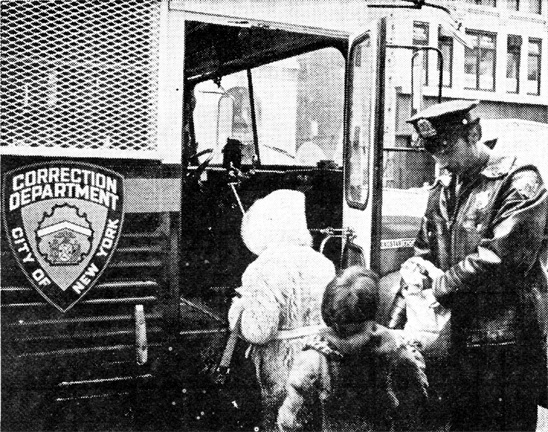The Department answered the
Mayor’s call for help in transporting
handicapped children to and from
schools throughout the city during the
school bus strike.
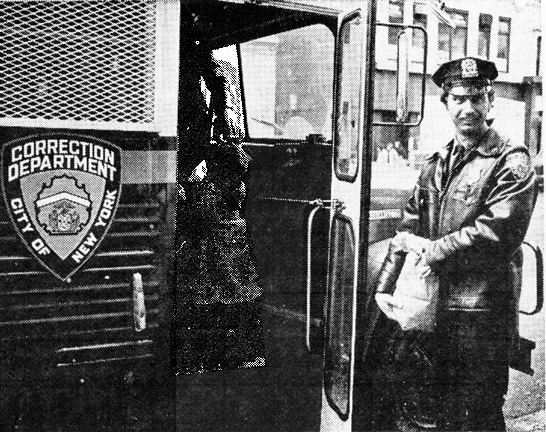
Inside the bus an officer helps a child board it as Correction Officer Manfred Hundertmark reaches in the bag for candy to give to the next youngster. |
|
Warden Frank
Colavito, Deputy Warden Albert Montemagno, and ADW Frederick Nash
realized that many personal sacrifices
would have to be made, so they asked
for volunteers.These 20 men deserve
a standing ovation.
They are:
Captain
David Delaney, Captain James Garvey,
C.O.’s Thomas Alanzo, Leonard Arena.
Frank Carello, Ronald Dawson, Frank
DeCastro, Pasquale DeSimone, Armondo
Estrada, Jerome Fant, Angelo Gallo,
Philip Grub, Manfred Hundertmark,
Chauncey Jones, Raymond Leslie, Joseph
Patrissi, Douglas Riddick, Michael
Romolo, Peter Salerno and Walter
Stewart.
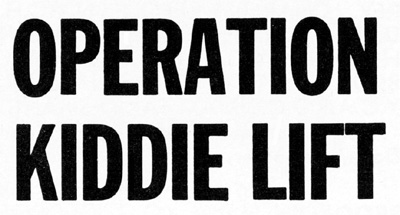
The story's headline "floated" with text above it and on both sides of it. The headline was positioned and centered atop the two photos, below which story text also appeared. |
|
Captain Garvey coordinated the entire effort, but he is quick to say that he
really didn’t do anything. He gives complete credit to the men.
A steady
4 p.m.-Midnight man, Garvey’s tour
was changed to a 5 a.m.-1 p.m. tour.
He arrived on Rikers lsland each morning at 4:30 a.m. to dispatch the buses
organize the runs, and to make certain
everyone left on time.
He acted as a
liaison between the Board of Education
and the Department. At the end of the
day, he checked the vehicles in, did the
paper work and logging for our records,
and finished his day at 7:00 p.m. With
pride, he says they had only three
mechanical breakdowns, no accidents, --
not even a single “fender bender” in the
five week operation.
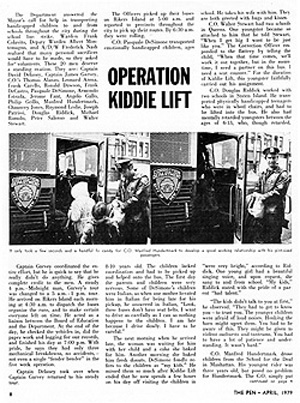
The two photos, side by side, appeared below the "floating" headline and shared a single caption that read: "It only took a few seconds and handful of candy for CO. Manfred Hundertmark to develop a good working relationship with his pint-sized passengers."
|
|
Captain Delaney took over when
Captain Garvey returned to his steady
tour.
The Officers picked up their buses
on Rikers Island at 5:00 a.m. and
reported to precincts throughout the
city to pick up their routes. By 6:30 a.m.
they were rolling.
C.O. Pasquale DeSimone transported
emotionally handicapped children, ages
8-10 years old. The children lacked
coordination and had to be picked up
and helped onto the bus. The first day
the parents and children were very
nervous.
Some of DeSimone’s children
were Italian, so when one mother berated
him in Italian for being late for his
pickup, he answered in Italian, “Look,
these buses don’t have seat belts. I want
to drive as carefully as I can so nothing
happens to the children. I am late
because I drive slowly. I have to be
careful.”
The next morning when he arrived
late, the woman was waiting for him
with her child and a cake she baked
for him. Another morning she baked
him fresh donuts. DeSimone fondly refers to the children as “my kids.” He
missed them so much after Kiddie Lift
ended that he now spends a few hours
on his day off visiting the children in
school. He takes his wife with him. The~
are both greeted with hugs and kisses.
C.O. Walter Stewart had two schools
in Queens. One youngster became so
attached to him that he told Stewart,
“When I get big I want to be just
like you.” The Correction Officer responded to the flattery by telling the
child, “When that time comes, we’ll
work it out together, but in the meanime, I need a partner on this bus. I
need a seat counter.” For the duration
of Kiddie Lift, this youngster faithfully
carried out his assignment.
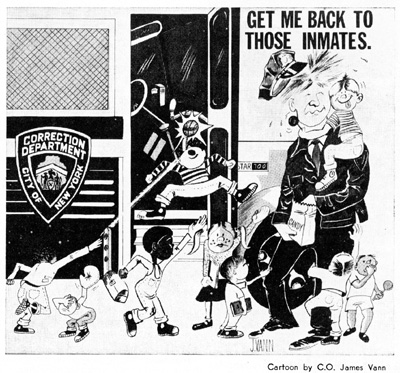
The cartoon by C.O. James Vann, a spoofing contradiction of the thrust of the article, appeared separately, on Page 6, not on Page 8 where the photos appeared and story text began, nor on Page 4 where the story text continued from Page 8. |
|
C.O. Douglas Riddick worked with
two schools in Staten Island. He transported physically handicapped teenagers
who were in wheel chairs, and had to
be lifted into the bus. He also had
mentally retarded youngsters between the
ages of 6-13, who, though retarded,
"were very bright,” according to Riddick. One young girl had a beautiful
singing voice, and upon request, she
sang to and from school. “My kids,”
Riddick stated with the pride of a parent “had talent.”
“The kids didn’t talk to you at first,”
he observed. “They had to get to know
you - to trust you. The younger children
were afraid of loud noises. Honking the
horn might upset them. You had to be
aware of this. They might be given to
violent outbursts and tantrums. You had
to have a lot of patience and understanding. It wasn’t hard.”
C.O. Manfred Hundertmark drove
children from the School for the Deaf
in Manhattan. His youngest rider was
three years old, but posed no problem
for Hundertmark. The C.O. simply put
him on the lap of his oldest passenger
who was 16, and everyone was happy.
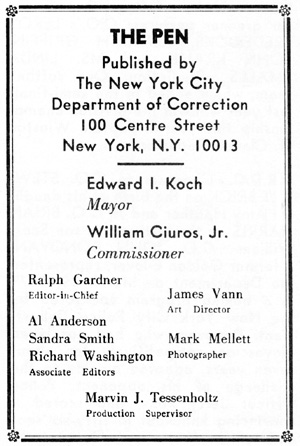
The staff box or masthead of the DOC publication.
|
|
The school provided him with a manual
alphabet card so he could fingerspell,
and with the assistance of the older
children, he had no problem communicating.
Hundertmark relates a story
about a 13 year old girl he fondly
nicknamed “The Tour Director.”
She
knew who was supposed to be on the
bus, who was missing, where everyone
lived, and the best way to get everyone
home.
The Officers were unanimous in
summing up the rewards and pleasure
derived from this unusual assignment.
“This was the most beautiful thing that
ever happened to us.”
“There was some-
thing very special about these childrçn."
“Either they didn’t talk to you, or they
kicked you, or they hugged you and
hung on to you.”
“Knowing they are
out there changes your life.” You
appreciate your own healthy kids.”
“It
opens your eyes and your heart.”
“I’d
do it again in a minute.”
